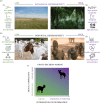Individual and ecological heterogeneity promote complex communication in social vertebrate group decisions
- PMID: 38768211
- PMCID: PMC11391315
- DOI: 10.1098/rstb.2023.0204
Individual and ecological heterogeneity promote complex communication in social vertebrate group decisions
Abstract
To receive the benefits of social living, individuals must make effective group decisions that enable them to achieve behavioural coordination and maintain cohesion. However, heterogeneity in the physical and social environments surrounding group decision-making contexts can increase the level of difficulty social organisms face in making decisions. Groups that live in variable physical environments (high ecological heterogeneity) can experience barriers to information transfer and increased levels of ecological uncertainty. In addition, in groups with large phenotypic variation (high individual heterogeneity), individuals can have substantial conflicts of interest regarding the timing and nature of activities, making it difficult for them to coordinate their behaviours or reach a consensus. In such cases, active communication can increase individuals' abilities to achieve coordination, such as by facilitating the transfer and aggregation of information about the environment or individual behavioural preferences. Here, we review the role of communication in vertebrate group decision-making and its relationship to heterogeneity in the ecological and social environment surrounding group decision-making contexts. We propose that complex communication has evolved to facilitate decision-making in specific socio-ecological contexts, and we provide a framework for studying this topic and testing related hypotheses as part of future research in this area. This article is part of the theme issue 'The power of sound: unravelling how acoustic communication shapes group dynamics'.
Keywords: communication; complexity; group decision-making; heterogeneity.
Conflict of interest statement
We declare we have no competing interests.
Figures

Similar articles
-
Parents' and informal caregivers' views and experiences of communication about routine childhood vaccination: a synthesis of qualitative evidence.Cochrane Database Syst Rev. 2017 Feb 7;2(2):CD011787. doi: 10.1002/14651858.CD011787.pub2. Cochrane Database Syst Rev. 2017. PMID: 28169420 Free PMC article.
-
Shared decision-making interventions for people with mental health conditions.Cochrane Database Syst Rev. 2022 Nov 11;11(11):CD007297. doi: 10.1002/14651858.CD007297.pub3. Cochrane Database Syst Rev. 2022. PMID: 36367232 Free PMC article.
-
Shared decision-making for people with asthma.Cochrane Database Syst Rev. 2017 Oct 3;10(10):CD012330. doi: 10.1002/14651858.CD012330.pub2. Cochrane Database Syst Rev. 2017. PMID: 28972652 Free PMC article.
-
Home treatment for mental health problems: a systematic review.Health Technol Assess. 2001;5(15):1-139. doi: 10.3310/hta5150. Health Technol Assess. 2001. PMID: 11532236
-
Personalised risk communication for informed decision making about taking screening tests.Cochrane Database Syst Rev. 2006 Oct 18;(4):CD001865. doi: 10.1002/14651858.CD001865.pub2. Cochrane Database Syst Rev. 2006. Update in: Cochrane Database Syst Rev. 2013 Feb 28;(2):CD001865. doi: 10.1002/14651858.CD001865.pub3. PMID: 17054144 Updated.
Cited by
-
The coevolution of cognition and sociality.Philos Trans R Soc Lond B Biol Sci. 2025 Jun 26;380(1929):20240110. doi: 10.1098/rstb.2024.0110. Epub 2025 Jun 26. Philos Trans R Soc Lond B Biol Sci. 2025. PMID: 40566915 Free PMC article. Review.
-
The power of sound: unravelling how acoustic communication shapes group dynamics.Philos Trans R Soc Lond B Biol Sci. 2024 Jul 8;379(1905):20230182. doi: 10.1098/rstb.2023.0182. Epub 2024 May 20. Philos Trans R Soc Lond B Biol Sci. 2024. PMID: 38768200 Free PMC article.
References
-
- Krause J, Ruxton GD. 2002. Living in groups. New York, NY: Oxford University Press. ( 10.1093/oso/9780198508175.001.0001) - DOI
-
- Delm MM. 1990. Vigilance for predators: detection and dilution effects. Behav. Ecol. Sociobiol. 26 , 337–342. ( 10.1007/BF00171099) - DOI
-
- Emlen ST. 1984. Cooperative breeding in birds and mammals. In Behavioural ecology: an evolutionary approach (eds Krebs JR, Davies NB), pp. 305–339. Oxford, UK: Blackwell Scientific Publications.
-
- Courchamp F, Macdonald DW. 2001. Crucial importance of pack size in the African wild dog Lycaon pictus. Anim. Conserv. 4 , 169–174. ( 10.1017/S1367943001001196) - DOI
-
- Isbell LA, Young TP. 1993. Social and ecological influences on activity budgets of vervet monkeys, and their implications for group living. Behav. Ecol. Sociobiol. 32 , 377–385. ( 10.1007/BF00168821) - DOI
Publication types
MeSH terms
LinkOut - more resources
Full Text Sources

